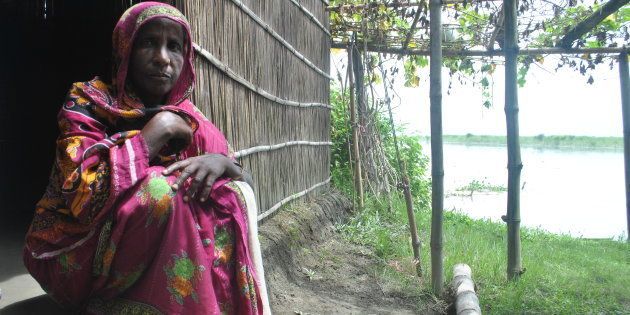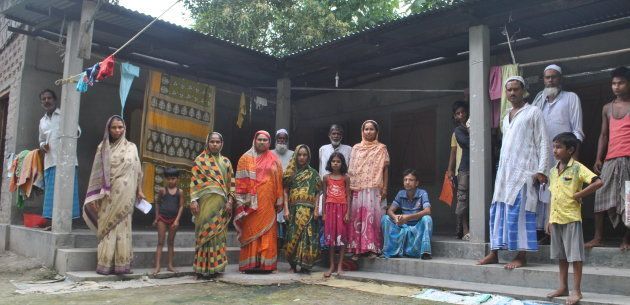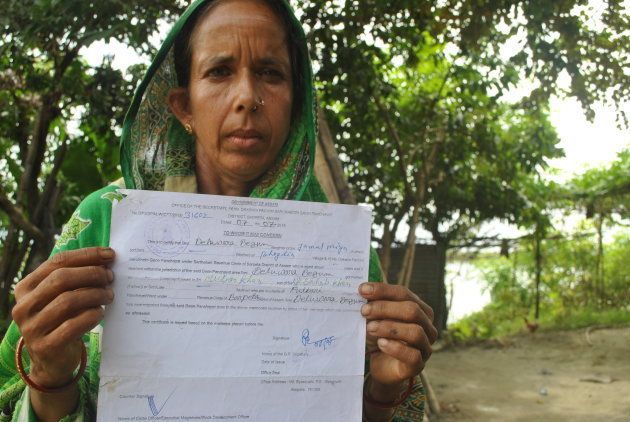
Alipur Char, ASSAM — "Do you think these are playthings? Stop hanging on them!" Rabiya Khatun shouted at her granddaughter trying to swing on the bottle gourd vines she'd laid out carefully. In response, the little girl shook her hips and stuck her tongue out.
"Joker," Rabiya said indulgently.
As Rabiya stretched to her full height, and took some firewood from the roof, the river licked at her toes. "Rain is kinder than the Brahmaputra," she said. "Good, the twigs are still dry."
Rabiya is in Alipur char – one of the most densely populated river islands on the Brahmaputra in Assam. She lives with her son, daughter-in-law and three grandchildren in a hut they built themselves, in a limb of sand extending from the main island. A room-sized box made of corrugated tin, bound with rope and wood, the hut is held in place by the river's clay.
When asked how long she had lived in her village, Rabiya said, "As long as the river has let me." Five years ago, as the clay shifted in the monsoon, her hut collapsed. They moved half a kilometre to where they stay now. This hut will fold soon too, in all likelihood. And Rabiya will move again, build a new hut, plant new vegetables, and adjust to erosion as she has her entire life.
With a life built on impermanence, and underscored by migration both long and short term, she could not fully grasp how a registry of citizenship was identifying people's movement around a cut-off date from nearly 50 years ago. But she understood the registry's import: "Being on it will prove I'm Indian."
Owning no land, having never gone to school, having delivered all her children at home and not the hospital, and dependent on her son's ration card, Rabiya had barely interacted with the Indian government. For her, being Indian meant did not mean a right to electricity, healthcare or schools. It meant "flood relief" and "no attacks".
Rabiya had been declared a doubtful voter, but a Foreigners Tribunal declared her Indian in early 2017. She then applied to the National Register of Citizens in Assam – she can't read and write, so her son helped her fill the form. On July 30, 2018, when the NRC's final draft list was released, she did not find her name on it. In truth, Rabiya didn't care, until everyone in Alipur – at least one person is excluded in every household – started to panic.
"How worried should I be?" asked Rabiya. "Some people say they will send us to Bangladesh. Why? I am from here."
Some people say they will send us to Bangladesh. Why? I am from here.

Char women left out
The challenges of living in a Char in Assam stem not only from the hostile geographical terrain, but also the abiding stereotype of char-dwellers as illegal Bangladeshi immigrants. These very reasons have also contributed to the overwhelming exclusion of char-dwellers, especially women, in the NRC list.
There are more than 2200 Char villages spread over 14 districts in Assam. Assamese Muslims and Dalits live near the river in upper Assam, and in rest, Muslims of East Bengal descent have lived for over a century. Peasant farmers, they came to cultivate grain in the fertile Brahmaputra valley, and settled in the mid-channel sand bars, adapting agricultural practices to suit the micro environment. Today, lakhs of people live on the islands, farming spinach and paddy, fishing and raising families—they constitute about 10 percent of Assam's population.
When the Brahmaputra floods in the monsoon, tens of thousands move into relief camps or on higher embankments, and across the state and country to labour in construction sites or brick-kilns. Repeatedly displaced by floods, and living in a society adhering to strict Islamist principles, the Char communities are the most marginalised in the state, and country. Its residents are debilitatingly poor – 68 percent of Char-households in Assam are below the poverty line. In the last state survey done in 2002-03, over 92 percent of the women and 81 percent of the men were found illiterate. Assam Human Development Report 2014 found that the average school-going years in Chars is 4.76 years – the lowest among all marginalised communities in Assam.
"Most people in Assam cannot imagine the resilience and vulnerability of people living in such an unpredictable setting," said Barpeta-based researcher Abdul Kalam Azad, who has been studying Chars there. "They wonder why anyone would live this way, moving all the time, never going to school. It makes them seem desperate – people think they must be illegal immigrants." Since most char-dwellers speak a dialect of Bengali, they're mistaken for Bangladeshis.
Most people in Assam cannot imagine the resilience and vulnerability of people living in such an unpredictable setting.
The NRC, which demands documentation to prove descendance to a person who lived in India before 24 March, 1971 (when Bangladesh declared independence), has been a loaded dice for women in the Chars.
In Barpeta district, which has the highest number of permanent and semi-permanent chars, literacy rate is just 26 percent. Shafiqul Khandakar, a school teacher from Alipur char, said that his classes were often empty, especially in the monsoon, when the river eroded villages and displaced people. "The few girls who come to school drop out by secondary school," he said.
"The high female illiteracy, isolation and conservative practises make patriarchy more entrenched in Assam's Chars," said Dhubri-based academic Parvin Sultana.
It's common for girls here – and for girls in tribes and adivasi communities in Assam— to marry almost immediately after puberty. The last survey found an average of four births per couple in Chars, but also an infant mortality rate double that of Assam's.
More hoops to jump through
Early marriage and illiteracy have a direct bearing on NRC inclusion. Rabiya's father, for instance, is listed in the NRC of 1951, which means he lived in Assam within the cut-off date. But because Rabiya didn't go to school, and married before the age of 21 (the voting age until 1988), she has no birth certificate, school admit card, or voter list entry. She has no documentation to prove links to her father.
For women like Rabiya, the NRC initially accepted a village headman's certificate certifying that she was her father's daughter, and had moved to her husband's village after marriage. But in 2017, NRC State Coordinator Prateek Hajela called it "a weak document", believing they were easily faked. Subsequently, the Gauhati High Court invalidated their use, but in December 2017, the Supreme Court clarified that they could be accepted after due verification.
Over 47 lakh women submitted a panchayat certificate as part of their NRC application. The Supreme Court didn't define a verification process, so the NRC came up with one. It marked some women applicants as 'original inhabitant' or OI, a special category that does not have an official definition – they were exempted from the stringent verification process.
"Verification without proper guidelines created a space for discrimination," said academic Sultana. "Officers gave Assamese-speaking women who submitted the same document the benefit of the doubt." An NRC official near Alipur Char confirmed this when he insisted that "Bengali Muslim women could be from outside. We have to be stricter with their certificate."
Verification without proper guidelines created a space for discrimination.
Over 29 lakh women did not fall under OI category and submitted panchayat certificates. This includes a large number of women from the Char areas – the NRC list has left much of this hugely marginalised group out.
For many in Assam, this would seem natural. "The Chars are full of Bangladeshis, so obviously that's where you will find the maximum exclusions," said Sammujjal Bhattacharya, the advisor to the Assamese nationalist All Assam Students Union that led the anti-foreigner agitation in the early sixties. "It is as if the bureaucratic process was built to confirm the stereotype," said researcher Abdul Kalam.
It is as if the bureaucratic process was built to confirm the stereotype.

In Alipur Char, twenty-something Delowar Khan hopped off the ferry, and asked us to visit his home. His mother and aunt were one of those who didn't make it to the NRC list. They had voter ID cards, but these were soiled when the river flooded their house. So, they too had submitted panchayat certificates.
The painfully shy mother, Delowara Begum, had married at the age of 14, and had not spoken to her father and four sisters since. "We met at the family verification hearing called by the NRC," she said. "My father didn't remember which daughter I was, or my name. My brothers confirmed me. But I don't think the officials believed us."
As we spoke, Rabiya had been busy. Within an hour in Alipur, over 45 people had gathered outside the house. All of them held NRC documents in their hand. All of them were excluded – one in almost every family in the village. All the women excluded had submitted nothing but panchayat link certificates. "Will we be declared foreigners?" asked a pregnant Rasmina Khatun, whose husband is in the CRPF.
Will we be declared foreigners?
From August 10, the NRC will start its claims and objections process, the last chance for people to appeal their exclusion. Many claims are likely to be from women who were excluded on the basis of the panchayat link certificate.
But what new proof can women left out provide?
When HuffPost India asked State Coordinator Prateek Hajela the question, he said, "We gave women every opportunity to prove their blood ties, with the verified certificate and through hearings. Claims will be a small fraction of initial applicants, so we will give more attention to each and every case now."
Correction: An earlier version of this story reported August 7 as the start date for claims and objections process. This has been changed to August 10. An earlier version of this story reported the name of the school teacher from Alipur char as Rinku. This has been changed to Shafiqul Khandakar.
Also on HuffPost India:
